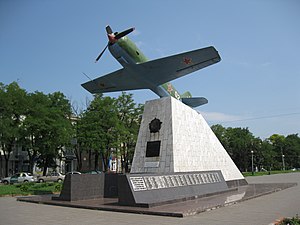Lavochkin La-11
| La-11 | |
|---|---|
 |
|
| Role | Fighter |
| National origin | Soviet Union |
| Manufacturer | Lavochkin |
| Primary users | Soviet air forces PLAAF |
| Produced | 1947-1951 |
| Number built | 1232 |
| Developed from | Lavochkin La-130 |
The Lavochkin La-11 (NATO reporting name Fang) was an early post-World War II Soviet long-range piston-engined fighter aircraft.
One of the recommendations from the government testing of Lavochkin La-130 (Lavochkin La-9 prototype) was to further develop it into a long-range escort fighter. The resultant La-134 prototype (also sometimes referred to as La-9M) featured increased fuel and oil capacity. Armament was reduced to three cannons. The prototype flew in May 1947. The second prototype, La-134D had fuel capacity increased by an additional 275 l (73 US gal) with wing and external fuel tanks. The aircraft was fitted with larger tires to accommodate the increased weight and amenities for long flights such as increased padding in the seat, armrests, and a urinal. In addition, a full radio navigation suite was installed. Not surprisingly, combat performance with a full fuel load suffered. However, as the fuel load approached that of La-9, so did the performance. The aircraft was found to be poorly suited for combat above 7,000 m (23,000 ft). The new fighter, designated La-11 entered production in 1947. By the end of production in 1951, a total of 1,182 aircraft were built.
The first documented combat use of La-11 took place on April 8, 1950, when four Soviet pilots shot down a United States Navy Consolidated PB4Y-2 Privateer over the Baltic Sea, with all 10 of the Privateer's crew lost. Later the same year, two La-11 pilots shot down a USN Lockheed P2V Neptune over the Sea of Japan near Vladivostok; one USN crew member was killed.
From February 1950, the Soviet 106th Fighter Aviation Division moved to Shanghai to defend it against bombing by the ROCAF. The division included the 351st Fighter Regiment, equipped with the La-11. On March 7, the regiment claimed a North American B-25 Mitchell bomber, shot down near Nanjing. On March 14, 1950, a Martin B-26 Marauder bomber was claimed in Xuzhou. On March 20, 1950, five La-11 pilots encountered a group of North American P-51 Mustangs north-west of Shanghai, although the P-51 pilots immediately retreated. On April 2, 1950, two P-51s were claimed by La-11 pilots over Shanghai. After that, MiG-15s of the Soviet 29th Fighter Regiment took over the air defence role. The ROCAF stopped bombing Shanghai that June and the Soviet units left in October 1950.
...
Wikipedia
